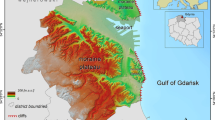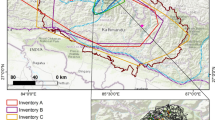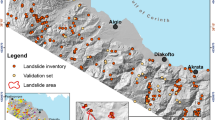Abstract
Kyrgyzstan is one of the most exposed countries in the world to landslide hazard. The large variability of local geological materials, together with the difficulties in forecasting heavy precipitation locally and in quantifying the level of ground shaking, call for harmonized procedures to better quantify the hazard and the negative impact of slope failures. By exploiting new advances in Geographic Information System (GIS) technology, together with concepts from Bayesian statistics, and promoting the use of open-source tools, we aim to identify areas in Kyrgyzstan where the potential for landslide activation exists. A range of conditioning factors and their potential impact on landslide occurrence are quantitatively assessed on the basis of the spatial distribution of landslides by applying weights-of-evidence modelling based on (1) a landslide inventory of past events, (2) terrain-derived variables of slope, aspect and curvature, (3) a geological map, (4) a distance from faults map, and (5) a seismic intensity map. A spatial validation of the proposed method has been performed, indicating sufficient measures of significance to predicted results. Initial results are promising and demonstrate the applicability of the method to all of Kyrgyzstan, allowing the identification of areas that are more susceptible to landslides with a level of accuracy greater than 70 %. The presented method is, therefore, capable of supporting land planning activities at the regional scale in places where only scarce data are available.











Similar content being viewed by others
References
Alalew L, Yamagishi H, Ugawa N (2004) Landslide susceptibility mapping using GIS-based weighted linear combination the case of Tsugawa area of Agano River. Niigata Prefecture Japan. Landslides 1:73–81
Aleotti P, Chowdhury R (1999) Landslide hazard assessment: summary review and new perspectives. Bull Eng Geol Environ 58:21–44
Bindi D, Abdrakhmaov K, Parolai S, Mucciarelli M, Grüntal G, Ischuk A, Mikhailova N, Zschau J (2012) Seismic hazard assessment in Central Asia: outcomes from a site approach. Soil Dyn Earthq Eng 37:84–91
Bonham-Carter GF (1994) Geographic Information Systems for Geoscientists: modelling with GIS Computer methods in the geosciences, vol 13. Pergamon Press, Oxford, p 398
Bonham-Carter GF, Agterberg FP, Wright DF (1989) Weights of evidence modelling: a new approach to mapping mineral potential. Stat Appl Earth Sci Geol Surv Canada 89–9:171–183
CAC DRMI—Central Asia and Caucasus Disaster Risk Management Initiative, Desk Study Review (2009)
Carrara A, Guzzetti F, Cardinali A, Reichenbach P (1999) Use of GIS technology in the prediction and monitoring of landslide hazard. Nat Hazards 20:117–135
Chung C-JF, Fabbri AG (2003) Validation of spatial prediction models for landslide hazard mapping. Nat Hazards 30:451–472
Dahal RK, Hasegawa S, Nonoumra A, Yamanaka M, Dhakal S, Paudyal P (2008) Predictive modelling of rainfall-induced landslide hazard in the Lesser Himalaya of Nepal based on weights-of-evidence. Geomorphology 102:496–510
Dai FC, Lee CF, Ngai YY (2002) Landslide risk assessment and management: an overview. Eng Geol 64:65–87
Fell R, Corominas J, Bonnard C, Cascini L, Leroi E, Savage WZ (2008) Guidelines for landslide susceptibility, hazard and risk zoning for land use planning. Eng Geol 102:85–98
Gemitzi A, Falalakis G, Eskioglou P, Petalas C (2011) Evaluating landslide susceptibility using environmental factors, fuzzy membership functions and GIS. Glob Nest J 13:28–40
Guzzetti F, Carrara A, Cardinali M, Reichenbach P (1999) Landslide hazard evaluation: a review of current techniques and their application in a multi-scale study Central Italy. Geomorphology 31:181–216
Guzzetti F, Reichenbach P, Cardinali M, Galli M, Ardizzone F (2005) Probabilistic landslide hazard assessment at the basin scale. Geomorphology 72:272–299
Havenith H-B, Strom A, Caceres F, Pirard E (2006) Analysis of landslide susceptibility in the Suusamyr region Tien Shan: statistical and geotechnical approach. Landslides 3:39–50
Holec J, Bednarik M, Šabo M, Minár J, Yilmaz I, Marschalko M (2013) A small-scale landslide susceptibility assessment for the territory of Western Carpathians. Nat Hazards 69:1081–1107
Kalmetieva ZA, Mikolaichuk AV, Moldobekov BD, Meleshko AV, Janaev MM, Zubovich AV (2009) Atlas of earthquakes in Kyrgyzstan. Central-Asian Institute for Applied Geosciences and United Nations International Strategy for Disaster Reduction Secretariat Office in Central Asia, Bishkek, p 75
Moldobekov B, Sarangoev A, Usupaev S, Meleshko A (1997) Prognosis of natural hazards on the territory of the Kyrgyz Republic. All-Press Bishkek Kyrgyzstan, p 172 (in Russian)
Molnar P, Tapponier P (1975) Cenozoic tectonics of Asia Effects of a continental collision. Science 189:419–426
Nadim F, Kjekstad O, Peduzzi P, Herold C, Jaedicke C (2006) Global landslide and avalanche hotspots. Landslides 3:159–173
Neuhäuser B, Terhorst B (2006) Landslide susceptibility assessment using “weights-of-evidence” applied to a study area at the Jurassic escarpment (SW-Germany). Geomorphology 86:12–24
Oh H-L, Lee S (2010) Landslide susceptibility mapping on Panaon Island, Philippines using a geographic information system. Environ Earth Sci 62:935–951
Petley D (2012) Global patterns of loss of life from landslides. Geology 40(10):927–930
Pradhan B, Oh H-J, Buchroithner M (2010) Weights-of-evidence model applied to landslide susceptibility mapping in a tropical hilly area. Geomatics Nat Hazards Risk 1(3):199–223
Remondo J, Gonzales A, De Teran JRD, Cendrero A, Fabbri A, Chung C-JF (2003) Validation of landslide susceptibility maps: examples and applications from a case study in Northern Spain. Nat Hazards 30:437–449
Roessner S, Wetzel H-U, Kaufmann H, Samagoev A (2005) Potential of satellite remote sensing and GIS for landslide hazard assessment in Southern Kyrgyzstan (Central Asia). Nat Hazards 35:395–416
Rosenfeld C (1994) The geomorphological dimensions of natural disasters. Geomorphology 10:27–36
Schicker R, Moon V (2012) Comparison of bivariate and multivariate statistical approaches in landslide susceptibility mapping at a regional scale. Geomorphology 161–162:40–57
Soeters R, Van Westen CJ (1996) Slope stability: recognition, analysis and zonation. In: Turner AK, Shuster RL (eds) Landslides: investigation and mitigation. Transportation Research Board, Special Report 247, pp 129–177
SRTM Shuttle Radar Topography Mission (2004) SRTM digital topographic data US Geological Survey’s EROS Data Center. ftp://e0mss21u.ecs.nasa.gov/srtm/. Accessed (2004-11-12)
Strom A (2013) Geological Prerequisites for Landslide Dams’ Disaster Assessment and Mitigation in Central Asia. In: Wang F, Miyajima M, Li T, Shan W, Fathani TF (eds) Progress of Geo-Disaster Mitigation Technology in Asia, pp 17–53
Strom AL, Korup O (2006) Extremely large rockslides and rock avalanches in the Tien Shan Mountains Kyrgyzstan. Landslides 3:125–136
Terzaghi K, Peck RB (1967) Soil mechanics in engineering practice. Wiley, New York, p 752
Tingdong L, Ujkenov BS, Kim BC, Tomurtogoo O, Petrov OV, Strelnikov SI (2008) Geological map of Central Asia and Adjacent Areas edt. by Geological Publishing House. Beijing China
Torgoev A, Havenith H-B (2013) Landslide Susceptibility, Hazard and Risk Mapping in Mailuu-Suu, Kyrgyzstan. In: Margottini C, Canuti P, Sassa K (eds) Landslide Science and Practice, vol 1, pp 505–510
Torgoev I, Alioshin Yu G, Torgoev A (2012) Monitoring landslides in Kyrgyzstan. In: Merkel B (ed) Freiberg Online Geology, pp 130–139
Trifonov VG, Soboleva OV, Trifonov RV, Vostrikov GA (2002) Recent geodynamics of the Alpine-Himalayan collision belt. Transactions of the Geological Institute RAS 541, p 224 (in Russian)
Van Westen CJ, Rengers N, Soeters R (2003) Use of geomorphological information in indirect landslide susceptibility assessment. Nat Hazards 30:399–419
Van Westen CJ, van Asch TWJ, Soeters R (2006) Landslide hazard and risk zonation—why is it still so difficult? Bull Eng Geol Environ 68:297–306
Varnes JD (1984) IAEG commission on landslides and other mass movements, landslide hazard zonation: a review of principles and practice. The UNESCO Press, Paris 63p
Yilmaz I (2010) The effect of the sampling strategies on the landslide susceptibility mapping by conditional probability and artificial neural networks. Environ Earth Sci 60:505–519
Acknowledgments
The research presented in this paper has been carried out under the project TIPTIMON—Tien Shan-Pamir Monitoring Program (Project 03G0809), funded by the German Ministry of Education and Research (BMBF), and with the support from FP7 project SENSUM (grant agreement 312972). We thank Z. Kalmetyeva and A. Meleshko from the Central Asian Institute for Applied Geosciences (CAIAG) for providing the landslide data. K. Fleming kindly revised our English. Finally, the authors would like to thank the editor and two anonymous reviewers for their useful comments, which improved the manuscript.
Author information
Authors and Affiliations
Corresponding author
Rights and permissions
About this article
Cite this article
Saponaro, A., Pilz, M., Wieland, M. et al. Landslide susceptibility analysis in data-scarce regions: the case of Kyrgyzstan. Bull Eng Geol Environ 74, 1117–1136 (2015). https://doi.org/10.1007/s10064-014-0709-2
Received:
Accepted:
Published:
Issue Date:
DOI: https://doi.org/10.1007/s10064-014-0709-2




